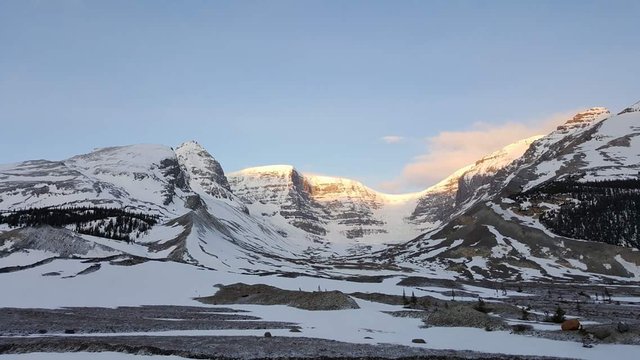

The Columbia Icefield is the "largest glacier in North America outside Alaska " – so big that it creates its own weather systems.
The drive to the Columbia Icefield is rated as one of the best in the world with colossal rugged peaks wrapped in prehistoric ice and endless valleys where nothing but wildlife roam.
According to Wikipedia:
- the Columbia Icefield is about 325 square kilometres (125 sq mi) in are,
- 100 metres (330 ft) to 365 metres (1,198 ft) in depth
- receives up to 7 metres (280 in) of snowfall per year
- the average elevation is 3000m (10,000 ft).
- the Columbia Icefield was formed during the Great Glaciation, or Illinoisan period (238,000 to 126,000 BC)
The Columbia Icefields is incredibly important for the northern hemisphere’s water supply as it feeds all three oceans – Arctic, Pacific and Atlantic.
The most accessible part of the Icefield is Athabasca Glacier.
According to Wikipedia,
- the glacier is approximately 6 km (3.7 mi) long
- covers an area of 6 km2 (2.3 sq mi)
- is measured to be between 90–300 metres (270 –1000 feet). The ice is as thick as the Eiffel Tower is high.
- It has icefall movement of 125m / year (400ft)
- It has turn around movement of 25m/year (80 ft)
- the icefalls elevation is 2700m (8900ft)
One of the must-do experience in the Canadian Rockies is Glacier adventure. Here, you’ll travel on a massive Ice Explorer to a where you can walk on, feel and drink from the Athabasca Glacier.
For more information, read it here.
All photos were taken during our trip to the Rockies last year.
Thanks for reading:)
WOW!!! Thank you for sharing these beautiful pictures. Upvoted and following you!
Have a look at my post about an abandoned hotel in Mozambique https://steemit.com/steemitphotochallenge/@rbfromsa/abandoned-hotel-xai-xai-mozambique, I think you might like it.
Please feel free to follow me @rbfromsa.
Downvoting a post can decrease pending rewards and make it less visible. Common reasons:
Submit